Appliqué is a needlework technique that involves adding smaller fabric shapes onto a larger piece of fabric, usually in some kind of ornamental way.
While we often hear the term appliqué in association with quilting, it’s also a technique that’s closely associated with embroidery. Some embroidery books out there address the very basics of appliqué, but finally, there’s a new book on the market that delves very (and I mean very) thoroughly into appliqué as it pertains to hand embroidery.
The book is called Appliqué: Techniques, Projects & Pure Inspiration, a Royal School of Needlework book by Kate Cross and published by Search Press.
If I had to pick one word to describe this book, it would be thorough. It is a Gem of a Book, full of precise, clear instruction, plenty of inspiration, and some nice projects to get you started in pursuing the wonders of appliqué with embroidery.
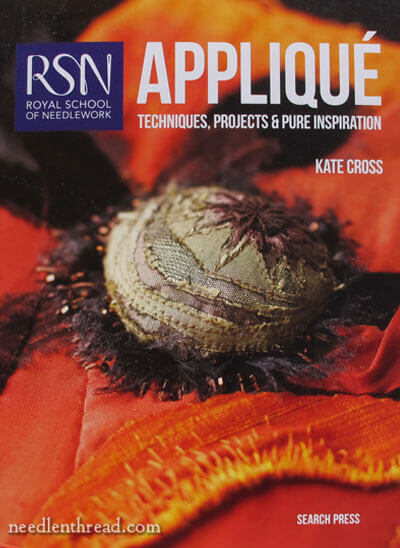
Unlike the previous books in the RSN Essential Stitch Guide series, Appliqué is a larger book, and it covers more than just the basics to get you started in the technique.
It’s a book that’s suitable for beginners who have never tried appliqué in embroidery, as well as for advanced embroiderers who want to take their embroidery to another level.
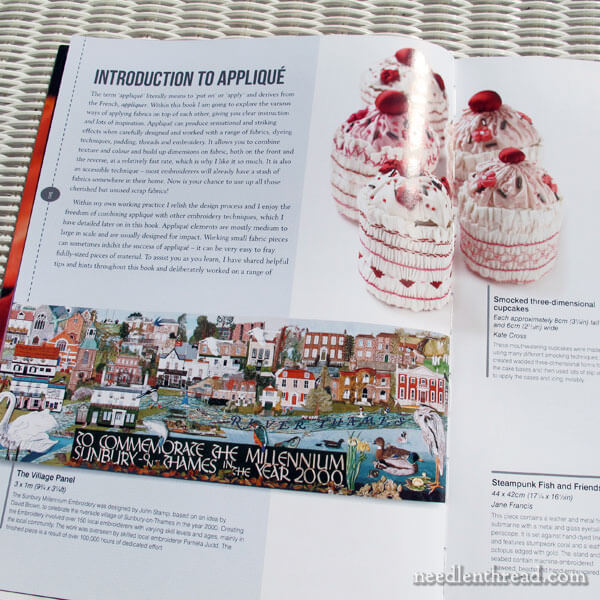
The book begins with a blurb on the Royal School of Needlework and moves right in to an introduction to appliqué – what it is, how it can be used, examples of its use in needlework. This is very readable material and gives a good overview.
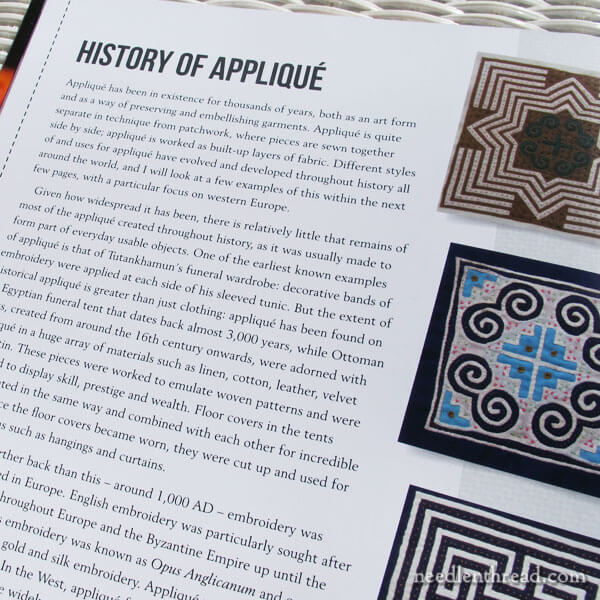
Next, we move on to the history of appliqué. Here, you’ll find images of the technique used throughout history and information on the development of appliqué techniques. Again, very readable – and picturesque!
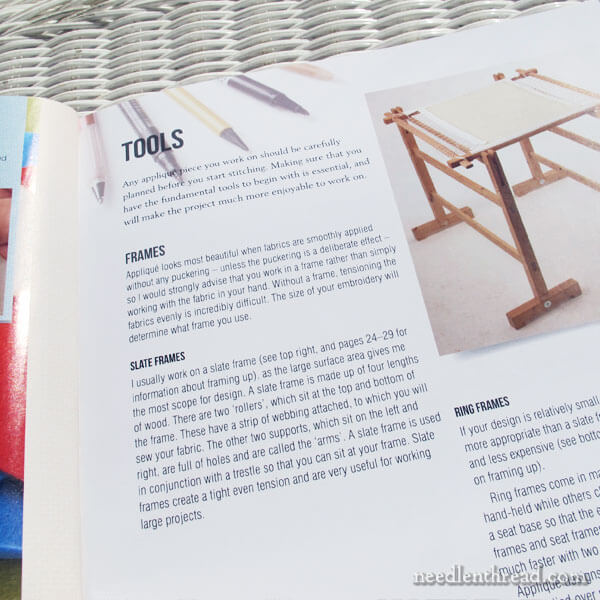
Next up, there’s a chapter on fabrics used in appliqué, followed by an extensive coverage of the tools required.
The tools are pretty much the same as the tools used in embroidery, surprisingly enough! There are a few extra gadgets that come in handy with appliqué work, and it’s not unusual to use an iron more frequently than you would with straight embroidery, but pretty much, if you’ve been embroidering for a while, you probably have all the tools you need.
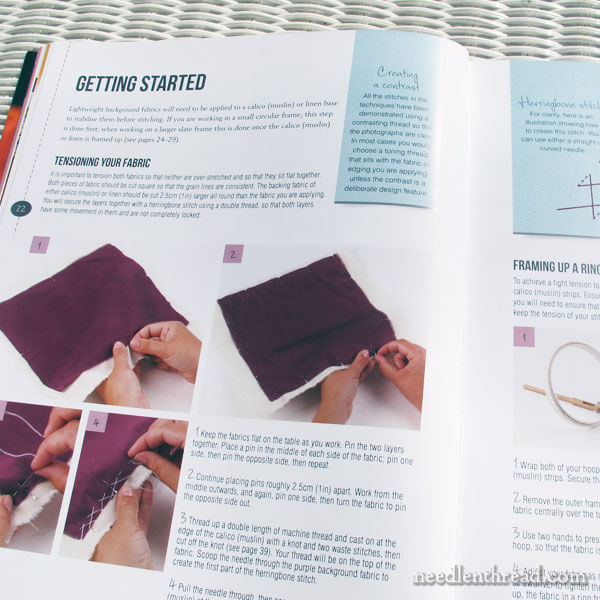
In the section “Getting Started,” you’ll find comprehensive instructions for setting up every aspect of your work, including mounting your work in a frame or in a hoop, and preparing your ground fabric.
As is usually the case with the RSN books, you’ll find very detailed instructions on using a slate frame. But in comparison to other RSN books, this one is even more detailed, with lots of clear, large photos of the equipment, of the framing-up process, and the like. Good stuff!
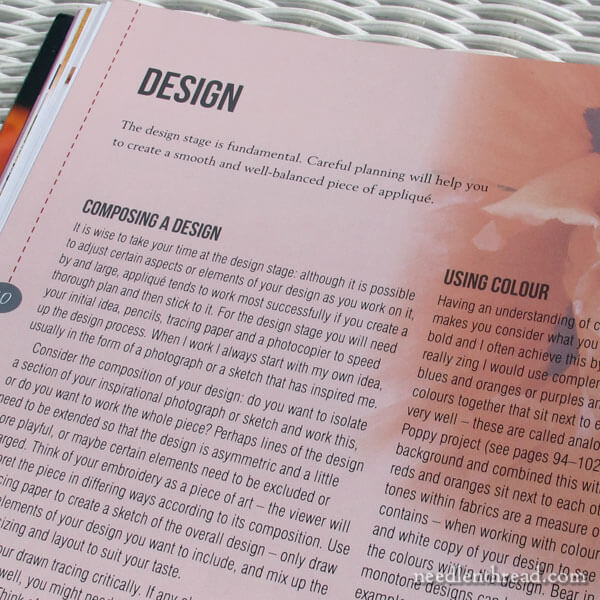
You’ll also find an excellent chapter on design, covering questions of what makes a good appliqué design and how to interpret a design into an appliqué piece.
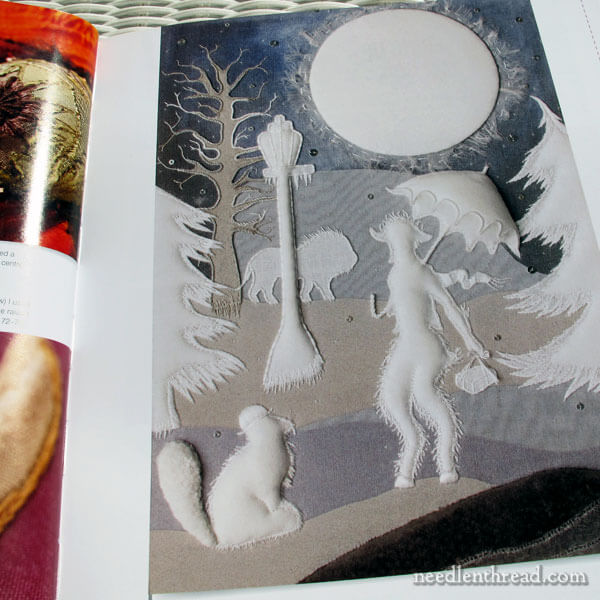
Here and there, throughout all this information, you will, of course, come across photos of appliqué projects that will inspire you to try the techniques for yourself.
Oh, Mr. Tumnus! How white and chilly you look!
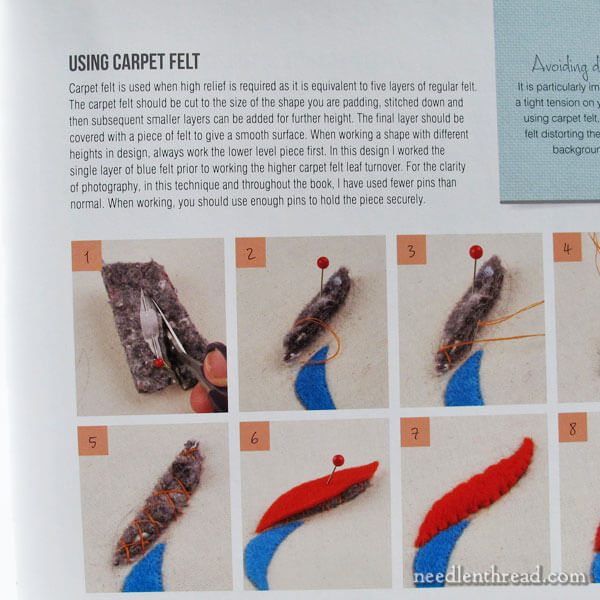
Before we get into the actual principles of appliqué, there are chapters on order of work, transferring your design, and essential starting techniques – all of which have excellent and useful information in them.
Then, we get into the fun part! The principles of building up! Appliqué in needlework relies on the building up of a foundation underneath the applied fabric and the author discusses several different ways to build up foundations in the chapters on building up and on padding in layers.
You’ll find instructions for felt padding, string padding, slip padding and trapunto padding.
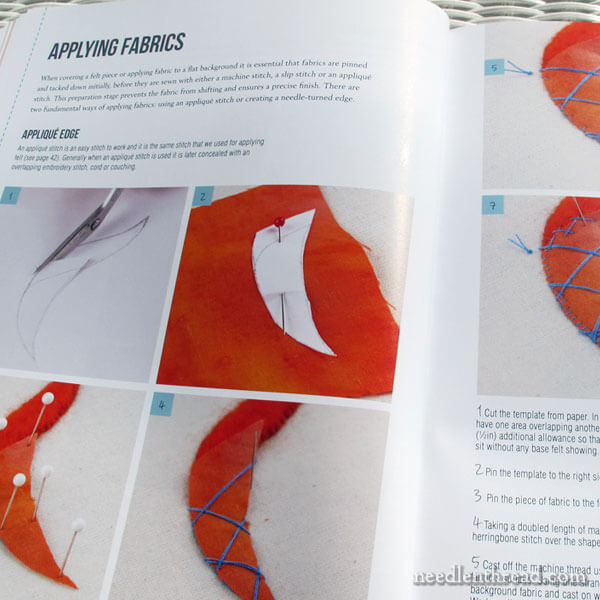
Following the building up, there’s a chapter on covering up – that is, applying the top layer of fabric over the built up foundations.
The author demonstrates the appliqué edge, the turned edge, and reverse appliqué.
The next chapter is devoted to adding interest with texture, and this is where we learn to use leather, add frayed and gathered fabrics, and use heavy weight interfacings.
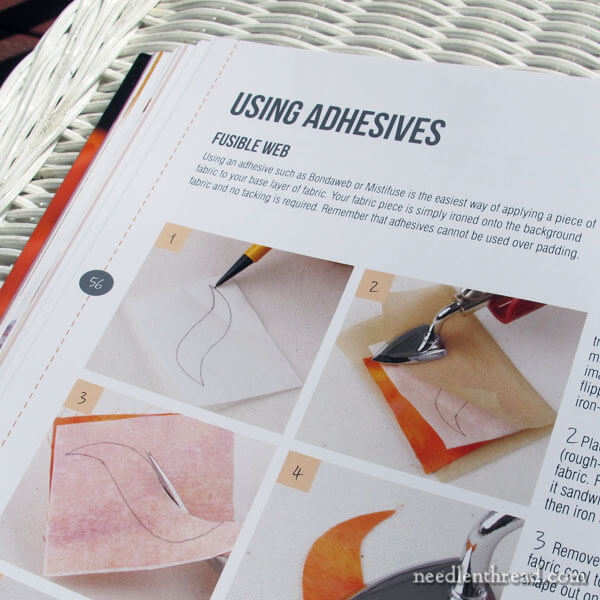
There’s an excellent chapter on using adhesives, with lots of tricks and tips that will help you use adhesives effectively.
Yes, adhesives. It really is ok to use adhesives for some techniques!
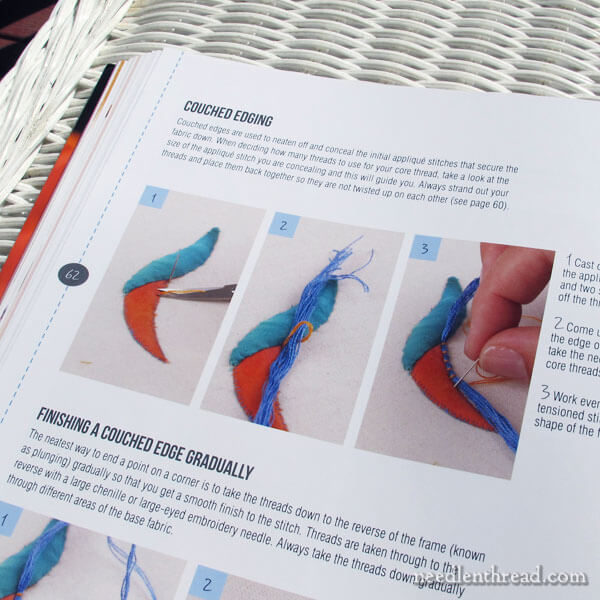
Once you get your fabric applied the way you want it, in the shape you want it, built up as much as you want it, there comes the question of embellishing.
Edging is a big part of appliqué work, so you’ll find a chapter devoted to all kinds of different ways you can edge an appliquéd element, with tips to help you through the tougher spots, like tight corners and the like.
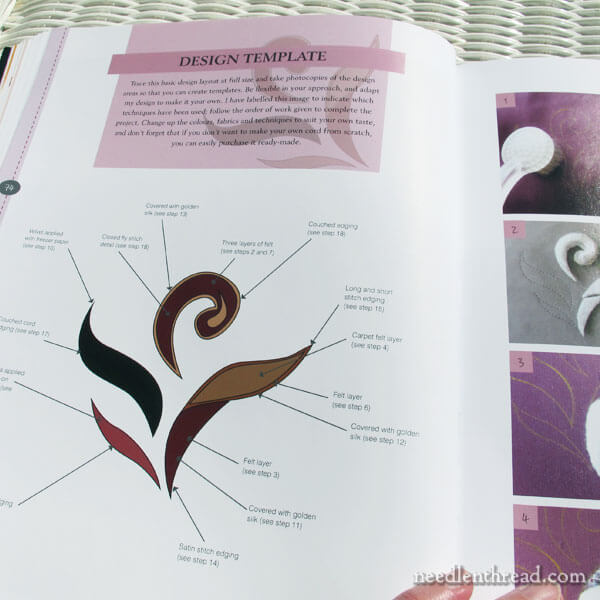
Then, we come to the projects. There are really only two projects in the book – a fern and a poppy.
In each project, you’ll find a design template, step-by-step photos of the order of work, supplies needed, and so forth.
Both are nice, but what’s really nice about them is that you’ll find, when reading through the projects, a lot more instruction to take in, that you can apply to your own undertakings.
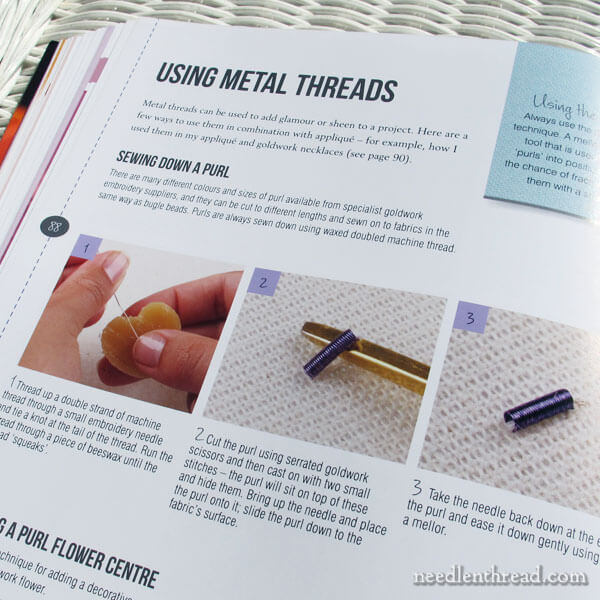
For example, you’ll find instructions on using metal threads…
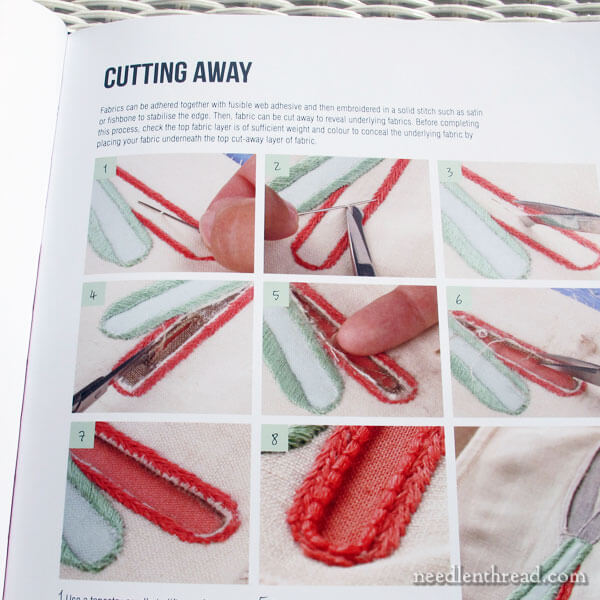
…and on cutting away fabrics for reverse appliqué techniques and the like.
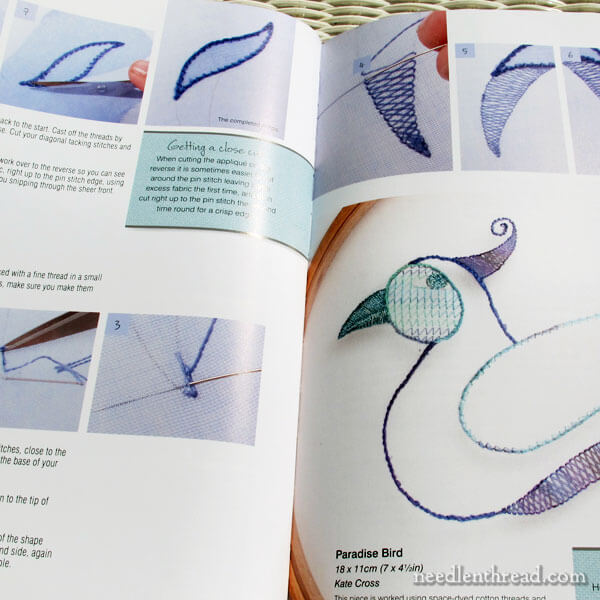
You’ll also discover how to use sheer fabrics and shadow work!
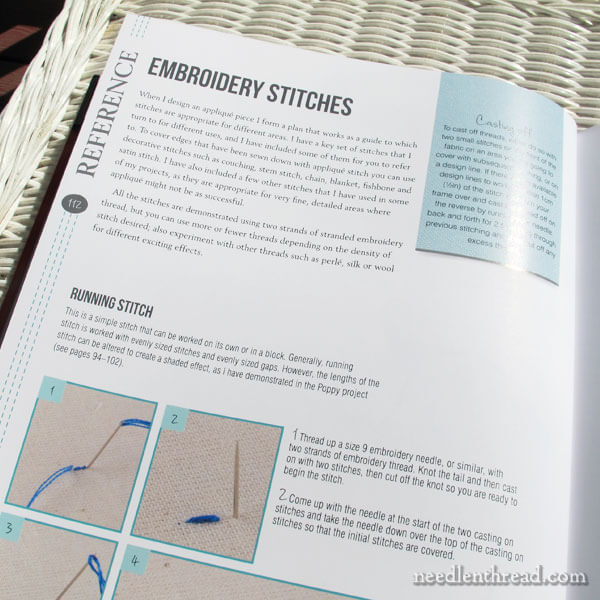
In the back of the book, there’s a reference section with embroidery stitches, featuring step by step photos of a variety of stitches…
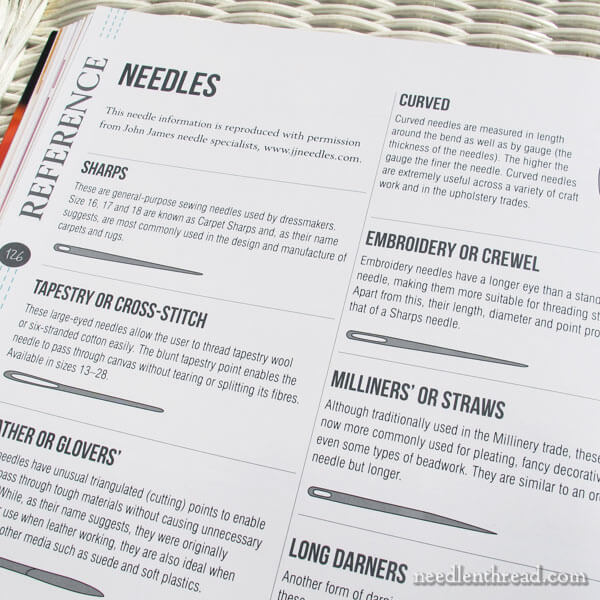
…along with an awesome needle reference chart!
There’s a glossary of terminology and an index at the back of the book, along with a short list of suppliers.
In a Nutshell
It’s been a long time since I’ve been as impressed with an instructional book as I am with this book. Sure, I’ve reviewed a lot of project books that are terrific – but when it comes to really detailed, comprehensive instruction, this book tops the charts in recently published instructional needlework books.
After reading it cover to cover, I didn’t find anything that was vague. It covers everything you need to know about the subject, and then some. It’s a really good book, and if you have any interest in adding the kind of dimension to your embroidery projects that appliqué affords, then this is definitely an instructional book you want on your shelf!
Especially for folks who are interested in ecclesiastical embroidery, embroidery from the 17th century and other historical periods, goldwork and other metal thread embroidery, the book is a must!
Where to Find It
You can find Appliqué: Techniques, Projects & Pure Inspiration from the following book affiliates:
In the US, Appliqué is available here through Amazon.
Worldwide with free shipping, you’ll find Appliqué available here at Book Depository.


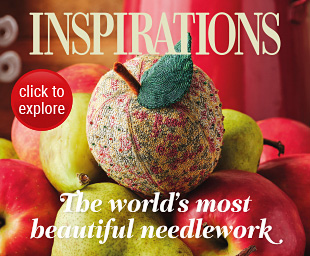


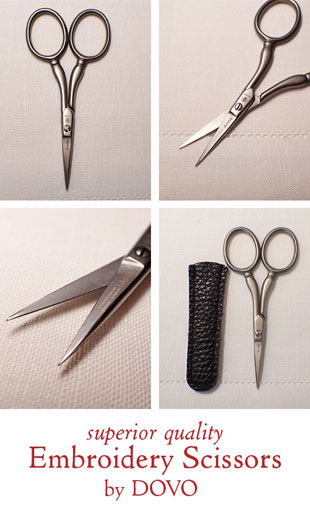
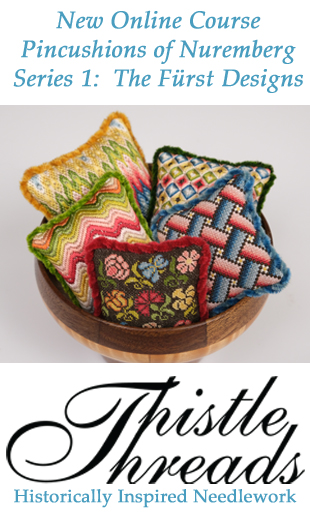
I have been looking for tutorials or information regarding appliqués. I want to hand-embroider, say a spray of roses.I want step by step how to embroider to be able to then cut it out, how to finish the appliqué work,and then apply to a garment. Thank you!
Dear Mary
I do like RSN books they are very instructional and have lots of photos on applying techniques. I like books that are detailed in their instructions and show lots of photos on techniques used as this book does. The Appliqué book looks very comprehesive in its instructions and lots of photos which I like. I will put this on my wish list. Thanks for reviewing the RSN Appliqué book and for sharing your views with us, it looks a great detailed instructional book.
Regards Anita Simmance
Mary, thanks so much for your review. I promptly ordered this book. As I looked through your comments, I see that the techniques are easily crossovers to some of the quilting I’m doing, as well as the (new to me) wool applique work.
One of the problems I have, as a beginner in embroidery is how to approach all those open spaces in a design. I’ve seen how filler stitches are used but am hesitant to “step off” into it.
I read your posts, daily and truly appreciate your excellent work! Thank you.
I do a lot of applique. I do mostly hand embroidery and applique and hand embroidery marry very well. Applique allows me to create layers that are then embellished and detailed with embroidery.
The book looks amazing. I’ve been a counted cross Stitcher for years and have recently got into wool applique and couldn’t find any information on that and now I want to learn more about applique with cotton as well. It’s going on my wish list of books.
You’ve done it again Mary and made me covet yet another book, despite the fact that I don’t do applique and will probably never do applique, but that doesn’t stop me wanting to read a book about applique!!!!
And … thanks, now I am waiting for delivery. Sometimes it is confusing to go through amazon looking for good book. Thank you, this is what I like , not project books but just techniques.
Thank you for the review, I had been considering getting this book, and now I will HAVE to buy it!
Good Morning Mary!
This sound like a great book for someone who enjoys embroidery as well as hand quilting. Applique is such a great way to combine both techniques. I just found out that I am going to England for Christmas. My husband told me he wants to take me to the RSN for a visit! I don’t know what I expect to find their, but it is exciting just to think that I will see it in person.
So interesting! And I loved the peeks into the book. Thanks for sharing, Mary.
Hello mary,
I had the opportunity to take part to a 2 week training at rsn with kate cross. She was unbelievably precise as in her book. Really a marvelous teacher deserving your comments. I was looking forward to the editing of her book and the first thing i did when reading your article was… Order it. Thank you so much for the information.
Something else I’ve not tried yet so another book on the list. Well, I’ve been very good lately and not bought one for ages!
I think you should publish a book on embroidering chicken scratch because I cannot find instructions other than reading yours on the internet. Please think about it.
Thank you
Phyllis
Hi Mary,
I went ahead and purchased the RSN Applique book. I waited very excitedly for it to arrive.
When it arrived I sat down with it immediately and was slightly disappointed. Yes, it did have some good information however it was lacking somehow. I was expecting more. More information on raised embroidery. Perhaps a section on raised gold work. I guess in my head I skipped over the word “applique” I tend to think of applique in the same realm of quilting not embroidery. I was thinking applique as in 17th century figures etc.
If one has never appliqued it is a great resource book. Yes, I did find some useful information and it was not expensive as books go. The photos were excellent and information clear. However, for me it lacked somehow.
Barbara L.
Well your review of this book has really got me interested and will bring looking to purchase it.
Thank you so much.
Mary,
Do you ever do ribbon embroidery? I use to long ago, I want to make change purses for all the girls in the family for Christmas presents. An I can not find the ribbon I use to use or patterns. Nothing, it’s like that part just disappeared and none of the women I have talked to here in my home town of San Antonio seem to have never heard of it. I would really like to get back in to that part of embroidery. I love doing my regular which I have been doing since I was about 7 or 8 years old. My Grandma taught me and I taught my Girl Scout troop when we were 11 or 12. I’m 60 now and honey I can’t begin to tell you just how many baby blankets I have made in all these years, for family, friends, hubby’s coworkers, neighbors…And I have never charged a dime for them. Now I’m ready to get back to my Ribbon Embroidery. I have look for books, and on line to no a veil. Please HELP. Thank you, Linda Jung
Hi, Linda – the best ribbon embroidery books are by Di van Neikerk. If you look her up on Amazon, you’ll find lots of options! I also have some of her books reviewed on my “Books” page, here: https://needlenthread.wpengine.com/books-links
I love you new site. I have to search for you now, you do not appear daily or whenever you posted something like before.
Hi, Velia – where do you normally access the blog? Through a feed reader, the daily email, or through a particular search engine? I’d love to know! Thanks!